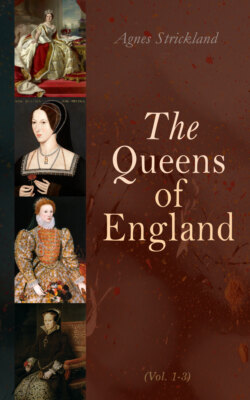Читать книгу The Queens of England (Vol. 1-3) - Strickland Agnes - Страница 22
На сайте Литреса книга снята с продажи.
ОглавлениеCHAPTER XI.
MARGUERITE OF FRANCE, SECOND QUEEN OF EDWARD I.
Table of Contents
(A.D. 1282–1317.)
King Edward I. was so grieved at the death of his "chère reine," that he gave himself up to the deepest melancholy, which lasted several months. He was growing old, and felt the loss of his companion of many years most keenly. However, he learned in time to submit to the inevitable, and roused himself to attend to the affairs of his kingdom.
No sooner did his ministers observe this favorable change in the mind of their monarch than they set to work to effect further improvement by seeking a successor to the defunct queen. Their choice fell on Marguerite, the sister of Philip le Bel of France.
A. D. 1299. After the usual preliminaries the treaty was duly signed, and the marriage was celebrated at Canterbury, Sept. 8, 1299.
Marguerite was only seventeen years old, but she was such a good, sedate and pious woman that her union with a man old enough to be her grandfather proved by no means an unhappy one. On the contrary, she exercised a wholesome influence over him, and prompted him to many merciful and worthy actions.
It was due to her persuasion that the poor widow, Lady Marguerite Howard, was released from a debt to the crown which she could not possibly have paid, and many of her subjects could cite similar acts prompted by her good and tender heart. The citizens of Winchester were deeply indebted to her for preserving them from King Henry's wrath when Bernard Pereres, a hostage from the city of Bayonne, made his escape. He had been confided to the care of the mayor of Winchester, and was looked upon as a prisoner of the greatest importance. King Edward placed a sheriff in charge of the city, deprived the people of all their liberties, fined the mayor three hundred marks, and shut him up in the Marshalsea prison until he should be able to pay the sum. The Winchester citizens were in despair, and threw themselves on the mercy of their queen. She recalled the exhibition of loyalty that they had made when she appeared among them a bride, and her heart warmed towards them in their distress. Fortunately, she was able to aid them, for the king had presented her with the charter of Winchester, thus entitling her to all the fines levied on its citizens. With this document she presented herself before her lord, and claimed the unfortunate mayor with his three hundred marks, as her property. Edward yielded, and even restored the liberties of which he had, in his displeasure, deprived the Winchester people. They never ceased to be grateful to Queen Marguerite.
But this occurred after she had been Edward's wife several years. We must return to the beginning of her reign.
On the Wednesday after his marriage, the king was suddenly and unexpectedly summoned to Scotland because of a rebellion that had broken out there. During his absence the queen occupied apartments in the Tower, and as the small-pox was raging in London that season, her court were quarantined in that palace.
The following year she joined the king in Scotland, but stopped at Brotherton in Yorkshire while he was fighting his battles.
A. D. 1300. On the first of June, 1300, her first child
was born. It was a boy, and Queen Marguerite gave him the name of Thomas, after the favorite English saint, Thomas à Becket of Canterbury.
The queen occupied Cawood Castle at that time, and during the four years she spent in that magnificent fortress, her husband was laying siege to one stronghold after another, until Scotland was subdued from sea to sea. Stirling Castle was the last one to yield, but when King Edward made his triumphal journey home to England, its brave commander, Wallace, was carried a captive in the royal train.
On their return to London, the king and queen gave a series of entertainments to celebrate the conquest of Scotland. One of the grandest tournaments ever witnessed in England took place at that time, at Westminster Palace, on which occasion Prince Edward and two hundred other noblemen were knighted. In 1308 the queen had another son. She named him Edmund, and he afterward became the Earl of Kent.
A. D. 1308. King Edward was on his way to Scotland in 1308, but fell ill before he reached the border. He lingered until the Prince of Wales reached him, and with his dying breath commanded his son, "to be kind to his little brothers, and, above all, to treat with respect and tenderness his mother, Queen Marguerite."
Much sorrow was felt at the death of their warrior king, but his wife mourned for the loss of the tender, affectionate husband Edward had always been.
A few months after his death she went to France to be present at the marriage of Edward II., with her niece, Isabella. On her return to England she lived in seclusion, devoting her time and money to deeds of charity. Marguerite died on the 14th of February, 1317, at the early age of thirty-six, and was buried at the Grey Friars church, a splendid building that she had founded.
A. D. 1317. Her stepson, Edward II., had always loved her, and to show his respect for her memory, he not only had her pall draped with rich material of silk striped with gold, but erected a splendid monument besides.
Queen Marguerite is the ancestress of all the English nobility bearing the name of Howard, who unite in their veins the blood of St. Louis with the greatest of the Plantagenet kings.
